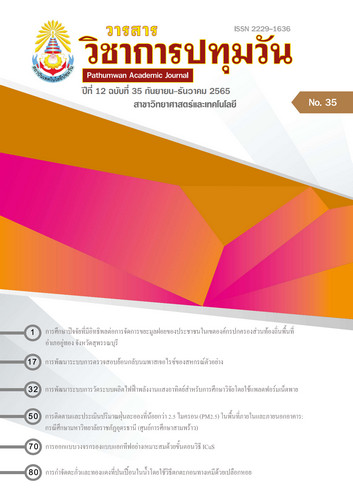การกำจัดตะกั่วและทองแดงที่ปนเปื้อนในน้ำโดยใช้วิธีตกตะกอนทางเคมีด้วยเปลือกหอย
Main Article Content
บทคัดย่อ
งานวิจัยนี้ได้ศึกษาการตกตะกอนทางเคมีโดยใช้เปลือกหอย 4 ชนิด เป็นสารตกตะกอนทางเคมี คือ เปลือกหอยนางรม เปลือกหอยแมลงภู่ เปลือกหอยแครง และเปลือกหอยลาย โดยศึกษาประสิทธิภาพการกำจัดโลหะหนัก(ตะกั่ว และทองแดง) ที่ปนเปื้อนในน้ำเสียสังเคราะห์ด้วยเปลือกหอยที่เตรียมจากอุณหภูมิ 200 และ 900 ºC ผลการศึกษาพบว่าเปลือกหอยที่เผาด้วยอุณหภูมิสูง 900 ºC สามารถกำจัดตะกั่วและทองแดงได้ดีกว่าเปลือกหอยที่อบด้วยอุณหภูมิ 200 ºC โดยมีประสิทธิภาพในการกำจัดโลหะหนักสูงสุดได้ 100 % และพบว่าเปลือกหอยลายสามารถกำจัดตะกั่วได้มากที่สุด คิดเป็น 50.07 % รองลงมา คือ เปลือกหอยแครง เปลือกหอยนางรม และเปลือกหอยแมลงภู่ คิดเป็น 49.15 %, 48.44 % และ 43.83 % ตามลำดับ นอกจากนั้นงานวิจัยนี้ได้ศึกษาเปรียบเทียบผลการกำจัดโลหะตะกั่วและทองแดงที่ช่วง pH 5, 7, 9 และ 11 พบว่าสภาวะที่เหมาะสมที่สุดในการกำจัดตะกั่วและทองแดงคือ pH 9 โดยทุกชนิดเปลือกหอย มีประสิทธิภาพในการกำจัดตะกั่วสูงที่สุดมีค่าระหว่าง 86 - 90 % และประสิทธิภาพในการกำจัดทองแดงสูงที่สุด เท่ากับ 90 %
Article Details

อนุญาตภายใต้เงื่อนไข Creative Commons Attribution-NonCommercial-NoDerivatives 4.0 International License.
เนื้อหาและข้อมูลในบทความที่ลงตีพิมพ์ใน Journal of Advanced Development in Engineering and Science ถือเป็นข้อคิดเห็นและความรับผิดชอบของผู้เขียนบทความโดยตรง ซึ่งกองบรรณาธิการวารสารไม่จำเป็นต้องเห็นด้วยหรือร่วมรับผิดชอบใดๆ
บทความ ข้อมูล เนื้อหา ฯลฯ ที่ได้รับการตีพิมพ์ในJournal of Advanced Development in Engineering and Science ถือเป็นลิขสิทธิ์ของ Journal of Advanced Development in Engineering and Science หากบุคคลหรือหน่วยงานใดต้องการนำทั้งหมดหรือส่วนหนึ่งส่วนใดไปเผยแพร่ต่อหรือเพื่อกระทำการใดๆ จะต้องได้รับอนุญาตเป็นลายลักษณ์อักษรจาก Journal of Advanced Development in Engineering and Scienceก่อนเท่านั้น

